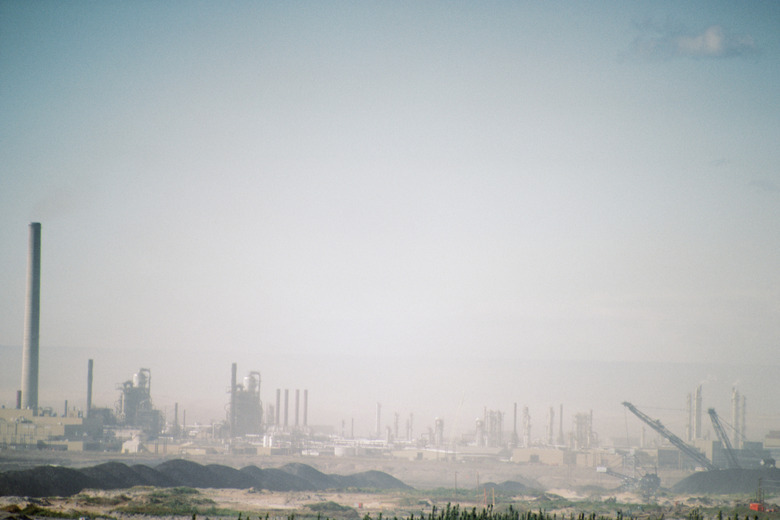Components Of Smog
Two types of smog pollute the air in industrial areas and large cities worldwide. The original smog – a combination of smoke and fog – occurs when emissions from factories that burn coal combine with fog. It's known as industrial smog, and since it was first recorded in London, it's also known as London smog.
Since the 1940s, a new type of smog caused primarily by emissions from automobiles and fossil fuel-burning power plants has bedeviled cities located near mountains on sunny, hot days. First noted in Los Angeles, this is photochemical smog, and it is different. In fact, smog composition varies significantly from London to Los Angeles. It's unusual to encounter both types of smog at once because they occur in different climates and different weather, but it can and does happen in sunny, industrial cities such as New Delhi.
Sulfur Dioxide Is a Main Component of Industrial or London Smog
Sulfur Dioxide Is a Main Component of Industrial or London Smog
Emissions from coal-burning factories have been a fact of life in Great Britain throughout the industrial age, and they were responsible for health problems throughout the 19th century. H.A. Des Voeux of the Smoke Abatement League of Great Britain first coined the term smog to describe the choking pollution in 1905 and later used it in a report at the 1911 Manchester Conference.
Sulfur dioxide is a main component of the smog that Des Voeux was describing. It's a by-product of the combustion of coal, and it combines with the moist air on foggy days to create an acidic, corrosive soup. Industrial smog also includes the unburnt particulate matter that wafts into the air when coal is burnt. On particularly foggy days, industrial smog can be heavy enough to restrict vision, and it has been responsible for thousands of deaths.
The Smog Composition in Los Angeles
The Smog Composition in Los Angeles
Starting around 1943, people in Los Angeles began to notice a yellow haze blanketing the city on hot, still days. The haze caused coughing, widespread respiratory problems, irritated eyes and even a significant number of cases of cancer. A few years of research revealed that automobile emissions were the main source of this smog. The name scientists use for it is photochemical smog, because it relies on sunlight for its formation, but it's popularly known as Los Angeles smog.
The pollutants in photochemical smog are formed in a complex process that begins with the emission of nitrogen oxides and volatile organic compounds (VOCs) from automobile tailpipes. These combine with both moisture in the air and oxygen to form ozone, and further reactions produce a variety of organic gases, including peroxyacyl nitrates (PANs), which cause severe eye irritation in high concentrations.
Which of the Following Is Not a Component of Smog?
Which of the Following Is Not a Component of Smog?
The following is a list of air pollutants known to cause adverse health effects and to deteriorate the quality of the air. Can you choose the one that is not a component of industrial or photochemical smog?
- Nitric acid
- Nitrous oxide
- Carbon dioxide
- Peroxyacyl nitrates (PANs)
- Sulfuric acid
- Ozone
If you chose carbon dioxide, you're right. It's a greenhouse gas and plays a starring role in global warming, but its concentration in the atmosphere doesn't increase on a smoggy day. If you're wondering how sulfuric acid made the list, it's formed when sulfur dioxide dissolves in rain and mist. Nitric acid is an even stronger acid, and it's formed when nitrogen oxides react with water vapor, oxygen and ozone. The release of nitrogen dioxides and the resulting pollution are one of the disadvantages of removing the catalytic converter from your automobile.
Cite This Article
MLA
Deziel, Chris. "Components Of Smog" sciencing.com, https://www.sciencing.com/components-smog-4233/. 15 August 2018.
APA
Deziel, Chris. (2018, August 15). Components Of Smog. sciencing.com. Retrieved from https://www.sciencing.com/components-smog-4233/
Chicago
Deziel, Chris. Components Of Smog last modified March 24, 2022. https://www.sciencing.com/components-smog-4233/
